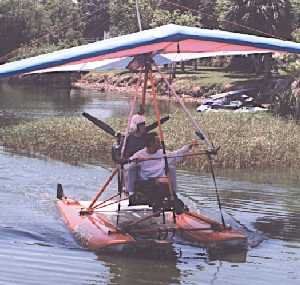
WELL-THOUGHT-OUT – Air Création put the time of development into this floatplane. It was highly stable on water even at higher speeds, and the water rudders worked efficiently.

WATERBORNE – Air Création uses a durable spray shield to protect the prop from float wake. Also note the water rudders at the rear of the floats; this is the only way to taxi a trike on water. Air Création factory pilot Franke Toussant posed for the photo.
Float-Equipped Air Création Trike
Trikes and floats offer the same fun potential as do floats on most ultralights. But they offer more challenge to make it work.
First of all, trikes leave the ground differently than most 3-axis ultralights. When the wing takes off, the chassis swings into place underneath it, pivoting forward several inches of displacement. While this makes landings easy (the main gear contacts earth first), this shift requires float fitting to be well-considered.
Then, you must develop a water rudder system, which isn’t particularly challenging except to keep everything light. Without such a system, a trike cannot be maneuvered in the water, unlike a rudder airplane which can steer by propblast against the rudder. The standard steering pedals are used in the same push- right go-left method of ground steering a trike.
I once tried to water taxi a trike (for a photo shoot of all things) back in the early ’80s, before water rudders had been developed for trikes. The wind picked up to about 25 mph, and the only way to get back was to alternately dip one wing tip in the water and then the other, pivoting around the wing tip to aim back to the beach in a drunken-looking weave. It wasn’t pretty.
Neither had anyone developed a spray shield such as you see Air Création uses. Without such a thing, trikes can spray water into the relatively low prop all too easily. Back in ’83, we went through three wood props in an hourlong period! You learn things.
Air Création is proud of their float system, charging $10,000 for the all-fiberglass set plus rudder and mount hardware, according to Rob Albright. Perhaps a lower-cost system will come along later, as the float option may get fewer takers at the current price, even though it, too, is finished in grand style.


Leave a Reply